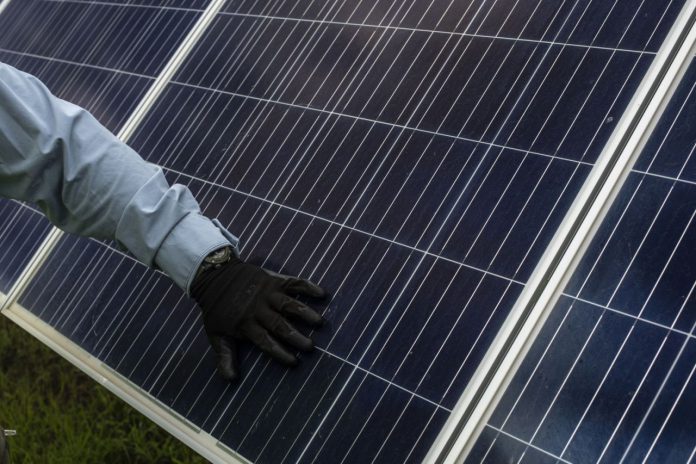The Trump administration on Wednesday will announce the authorization of a roughly 3,000-acre solar farm near Palm Springs, California, after developers scaled back its size to help avoid threatened desert tortoises and cultural artifacts.
First Solar Inc.’s 450-megawatt Desert Quartzite project in eastern Riverside County has been praised by some environmentalists for its careful design on lands teeming with protected species and relics.
“It’s a big project, over 2,700 acres. That’s no small chunk of land, and they’re going to squeeze 450 megawatts out of that,” said Casey Hammond, the Interior Department’s acting assistant secretary of land and minerals management. “If you look at how they scaled it down from where they first were — it’s 1,000 acres less — and what they’re going to crank out of there, utility payers should get a good value.”
The project, being developed by Desert Quartzite LLC, a wholly owned subsidiary of First Solar, is expected to be in operation by 2022. The Interior Department said it would produce enough electricity to power about 117,000 homes while providing about $2.7 million in annual rent and fees to the U.S. Treasury. No utility has yet signed an agreement to purchase power generated at the site.
The Interior Department’s approval comes despite President Donald Trump’s criticism of renewable energy, including disparaging solar power as “very, very expensive” last spring. Even so, his administration has moved methodically to advance several solar projects on federal lands.
For instance, in November, the Interior Department’s Bureau of Land Management approved EDF Renewable Energy’s 500-megawatt Palen Solar Project, which is slated to encompass 3,140 acres in Riverside County. A month later, the agency issued a final environmental analysis, setting the stage to soon approve the 690-megawatt Gemini solar project advanced in Nevada by Warren Buffett’s NV Energy Inc.
The projects are being propelled by California’s ambitious renewable energy goals, including a commitment for zero-emission electricity by 2045.
Small, rooftop solar installations aren’t enough to help make a huge shift and satisfy that pledge, said Shannon Eddy, executive director of the Large-Scale Solar Association, which advocates for bigger, utility-scale projects.
“I would love to be able to say, sure, let’s do it all on rooftops and we don’t need it anywhere else, but it’s not going to be enough energy,” Eddy said in a telephone interview. “We need all the rooftop we can get, we need all the utility scale we can get, and we need it soon.”
First Solar’s shares were down 9.8% to $53.05 as of 11:14 a.m. Wednesday, after Barclays Plc downgraded its rating to underweight from overweight and slashed its price target to $49.
Environmental Considerations
The sun-drenched Southwest U.S. is prime territory for solar farms. The California desert is rivaled only by northern Africa in its solar radiance — a measure of electromagnetic radiation from the sun, Eddy said.
Still, some conservationists have raised concerns about the planned solar construction, arguing the projects would ravage pristine desert lands and imperil desert tortoises, lizards and protected plants. Native Americans also have also fought the projects, with tribal leaders arguing that Desert Quartzite and other ventures planned along the Interstate 10 corridor in eastern Riverside County could destroy sacred sites.
Interior’s Hammond stressed that state and federal regulators had worked with developers to minimize environmental impacts. Where oil drilling and other projects on public lands might have a relatively small — and temporary — footprint, solar projects endure longer, keeping ATV riders, hikers and other people from using the territory.
“That’s a big consideration,” Hammond said in an interview. “Are we willing to take a big chunk of public land from the public but say this is still the highest and best use of it? In this case, we were able to make that determination; this is the highest and best use, at this time, for this land.”






